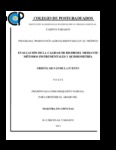| dc.contributor.author | Silván de la Fuente, Cristel | |
| dc.creator | SILVAN DE LA FUENTE, CRISTEL; 386912 | |
| dc.date.accessioned | 2013-07-29T23:17:24Z | |
| dc.date.available | 2013-07-29T23:17:24Z | |
| dc.date.issued | 2013 | |
| dc.identifier.uri | http://hdl.handle.net/10521/1975 | |
| dc.description | Tesis (Maestría en Ciencias, especialista en Producción Agroalimentaria en el Trópico).- Colegio de Postgraduados, 2013. | en_US |
| dc.description.abstract | El biodiesel es un combustible líquido que consiste en esteres monoalquil de cadenas largas de ácidos grasos derivados de aceites vegetales o grasas animal, que pueden ser usadas como sustituto de combustible diésel. Los principales motivos que llevaron a los diferentes países a impulsar la producción de biodiesel son garantizar la seguridad energética, reducir los gases de efecto invernadero, así como contribuir al desarrollo del sector rural. Para su uso, la calidad del biodiesel es generalmente controlada en base a parámetros físicos y químicos establecidos por normas técnicas aprobadas en cada país. Las principales normas técnicas para el biodiesel son la europea (EN 14214) y la estadounidense (ASTM D6751-07). Sin embargo, los métodos establecidos en ambas normas consumen tiempo, reactivos, además de aumentar la probabilidad de error por la manipulación de la muestra. La tendencia actual de la Química Analítica es resolver el problema planteado con el menor esfuerzo posible. Y los métodos instrumentales junto con la interpretación quimiométrica de la información generada con esta tecnología, son una opción para reducir el tiempo de análisis, el consumo de reactivos; así como reducir la probabilidad de error analítico. La presente investigación consistió en evaluar si la información generada con métodos instrumentales espectroscopia de ultravioleta-visible (UV/Vis), es información útil y suficiente para establecer un modelo discriminante para clasificar biodiesel y mezclas y desarrollar un modelo para estimar la concentración de biodiesel en diésel. Los resultados indican que las huellas espectrales del UV-Vis son información suficiente para establecer modelos de clasificación y estimación, para evaluar la calidad de biodiesel de aceite vegetal refinado, usado y de mezclas diésel-biodiesel. _______________ QUALITY ASSESSMENT OF BIODIESEL BY INSTRUMENTAL METHODS AND CHEMOMETRIC. ABSTRACT: The biodiesel is a liquid fuel that consists in cover monoalquil of long chains of oily acids derived from vegetable oils or fats animal, which they can be used as substitute of diesel fuel. The principal motives that led to the different countries to stimulating the production of biodiesel are to guarantee the energetic safety, to reduce the greenhouse gases, as well as to contribute to the development of rural sector. For his use, the quality of the biodiesel is generally controlled on the basis of physical parameters and chemists established by technical procedure approved in every country. The principal technical procedure for the biodiesel is the European (IN 14214) and the American (ASTM D6751-07). Nevertheless, the methods established in both procedures consume time, reagents, beside increasing the probability of mistake for the manipulation of the sample. The current trend of the Analytical Chemistry is to solve the problem raised with the minor possible effort. And the instrumental methods together with the chemometric interpretation of the information generated with this technology, are an option to reduce the time of analysis, the consumption of reagents; as well as to reduce the probability of analytical mistake.
The present investigation consisted to evaluate if the information generated with instrumental methods spectroscopy of ultraviolet - visible (UV/Vis) it is a useful and sufficient information to establish a model discriminate to classify biodiesel and you mix; and a model develops to estimate the concentration of biodiesel in diesel. The results indicate that the spectral fingerprints of the UV-Vis are sufficient information to establish models of classification and estimation, to evaluate the quality of the biodiesel of vegetable refined, secondhand oil and of mixtures diesel-biodiesel. | en_US |
| dc.description.sponsorship | Consejo Nacional de Ciencia y Tecnología (CONACYT). | en_US |
| dc.language.iso | spa | en_US |
| dc.rights.uri | http://creativecommons.org/licenses/by-nc-nd/4.0 | |
| dc.subject | Biodiesel | en_US |
| dc.subject | Mezclas diésel-biodiesel | en_US |
| dc.subject | Huellas espectrales | en_US |
| dc.subject | Quimiometría | en_US |
| dc.subject | Diesel-biodiesel blend | en_US |
| dc.subject | Spectral fingerprints | en_US |
| dc.subject | Chemometric | en_US |
| dc.subject | Producción Agroalimentaria en el Trópico | en_US |
| dc.subject | Maestría | en_US |
| dc.title | Evaluación de la calidad de biodiesel mediante métodos instrumentales y quimiometría | en_US |
| dc.type | Tesis | en_US |
| Tesis.contributor.advisor | Guerrero Peña, Armando | |
| Tesis.contributor.advisor | Bucio Galindo, Adolfo | |
| Tesis.contributor.advisor | Carrillo Avila, Eugenio | |
| Tesis.date.submitted | 2013 | |
| Tesis.date.accesioned | 2013-07-04 | |
| Tesis.date.available | 2013-07-29 | |
| Tesis.format.mimetype | pdf | en_US |
| Tesis.format.extent | 1,828 KB | en_US |
| Tesis.subject.nal | Acidos grasos | en_US |
| Tesis.subject.nal | Fatty acids | en_US |
| Tesis.rights | Acceso abierto | en_US |
| Articulos.subject.classification | Combustibles líquidos | en_US |
| dc.type.conacyt | masterThesis | |
| dc.identificator | 6 | |
| dc.contributor.director | GUERRERO PEÑA, ARMANDO; 211227 | |


